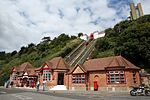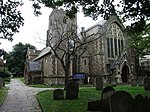Leas Cliff Hall
FolkestonePerformance art venuesTheatres in KentUse British English from December 2016

Leas Cliff Hall is an entertainment and function venue situated in Folkestone, on the Kent coast of England. The Grand Hall seats 900 and it has a standing capacity of 1500. It currently presents a varied programme of touring shows including concerts, comedy, ballet and wrestling.
Excerpt from the Wikipedia article Leas Cliff Hall (License: CC BY-SA 3.0, Authors, Images).Leas Cliff Hall
The Leas, Folkestone and Hythe District Foord
Geographical coordinates (GPS) Address Nearby Places Show on map
Geographical coordinates (GPS)
| Latitude | Longitude |
|---|---|
| N 51.0758 ° | E 1.17357 ° |
Address
Leas Cliffe Hall
The Leas
CT20 2DZ Folkestone and Hythe District, Foord
England, United Kingdom
Open on Google Maps










